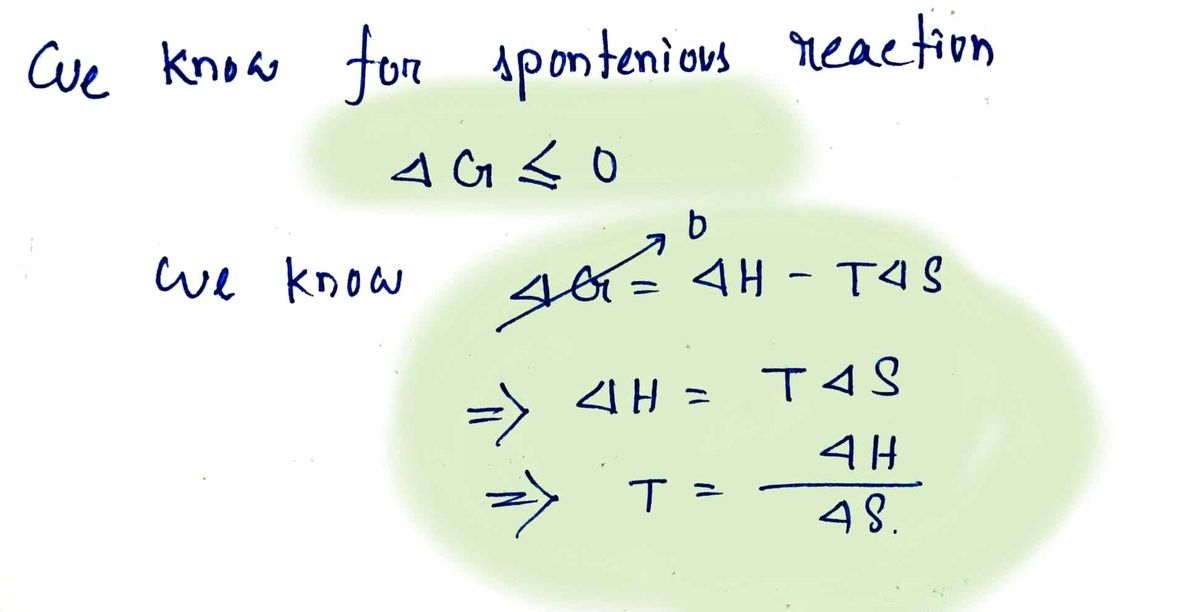The reaction of methane with water to form carbon dioxide and hydrogen is non- spontaneous at 298 K. At what temperature will this system make the transition from non-spontaneous to spontaneous? The following data is valid at 298 K: CH4(g) + 2H2O(g) = Substance: CH4(8) CO2(8) + 4H2(g) H20(g) CO2(3) H2(g) -74.87 -241.8 -393.5 (kJ/mol): AG (kJ/mol): S(J/K • mol): -50.81 -228.6 -394.4 186.1 188.8 213.7 130.7 HINT: Calculate AHxn. A So°, then determine T, must show work, write final answers below, upload work
The reaction of methane with water to form carbon dioxide and hydrogen is non- spontaneous at 298 K. At what temperature will this system make the transition from non-spontaneous to spontaneous? The following data is valid at 298 K: CH4(g) + 2H2O(g) = Substance: CH4(8) CO2(8) + 4H2(g) H20(g) CO2(3) H2(g) -74.87 -241.8 -393.5 (kJ/mol): AG (kJ/mol): S(J/K • mol): -50.81 -228.6 -394.4 186.1 188.8 213.7 130.7 HINT: Calculate AHxn. A So°, then determine T, must show work, write final answers below, upload work
Chemistry
10th Edition
ISBN:9781305957404
Author:Steven S. Zumdahl, Susan A. Zumdahl, Donald J. DeCoste
Publisher:Steven S. Zumdahl, Susan A. Zumdahl, Donald J. DeCoste
Chapter1: Chemical Foundations
Section: Chapter Questions
Problem 1RQ: Define and explain the differences between the following terms. a. law and theory b. theory and...
Related questions
Question

Transcribed Image Text:The reaction of methane with water to form carbon dioxide and hydrogen is non-
spontaneous at 298 K. At what temperature will this system make the transition
from non-spontaneous to spontaneous? The following data is valid at 298 K:
CHĄ(g) + 2H2O(g) =CO2(g) + 4H2(g)
H2O(g)
Substance: CH4(8)
CO2(3)
H2(g)
-74.87
-241.8
-393.5
(kJ/mol):
AGf
-50.81
-228.6
-394.4
(kJ/mol):
S(J/K •
mol):
186.1
188.8
213.7
130.7
HINT: Calculate AH pxn. A So, then determine T, must show work, write final answers
below, upload work.
Expert Solution
Step 1
To become the spontaneous reaction it must have change in Gibbs free energy negative. In order to do so we have the formulas to calculate temperature.

Trending now
This is a popular solution!
Step by step
Solved in 3 steps with 2 images

Knowledge Booster
Learn more about
Need a deep-dive on the concept behind this application? Look no further. Learn more about this topic, chemistry and related others by exploring similar questions and additional content below.Recommended textbooks for you

Chemistry
Chemistry
ISBN:
9781305957404
Author:
Steven S. Zumdahl, Susan A. Zumdahl, Donald J. DeCoste
Publisher:
Cengage Learning

Chemistry
Chemistry
ISBN:
9781259911156
Author:
Raymond Chang Dr., Jason Overby Professor
Publisher:
McGraw-Hill Education

Principles of Instrumental Analysis
Chemistry
ISBN:
9781305577213
Author:
Douglas A. Skoog, F. James Holler, Stanley R. Crouch
Publisher:
Cengage Learning

Chemistry
Chemistry
ISBN:
9781305957404
Author:
Steven S. Zumdahl, Susan A. Zumdahl, Donald J. DeCoste
Publisher:
Cengage Learning

Chemistry
Chemistry
ISBN:
9781259911156
Author:
Raymond Chang Dr., Jason Overby Professor
Publisher:
McGraw-Hill Education

Principles of Instrumental Analysis
Chemistry
ISBN:
9781305577213
Author:
Douglas A. Skoog, F. James Holler, Stanley R. Crouch
Publisher:
Cengage Learning

Organic Chemistry
Chemistry
ISBN:
9780078021558
Author:
Janice Gorzynski Smith Dr.
Publisher:
McGraw-Hill Education

Chemistry: Principles and Reactions
Chemistry
ISBN:
9781305079373
Author:
William L. Masterton, Cecile N. Hurley
Publisher:
Cengage Learning

Elementary Principles of Chemical Processes, Bind…
Chemistry
ISBN:
9781118431221
Author:
Richard M. Felder, Ronald W. Rousseau, Lisa G. Bullard
Publisher:
WILEY